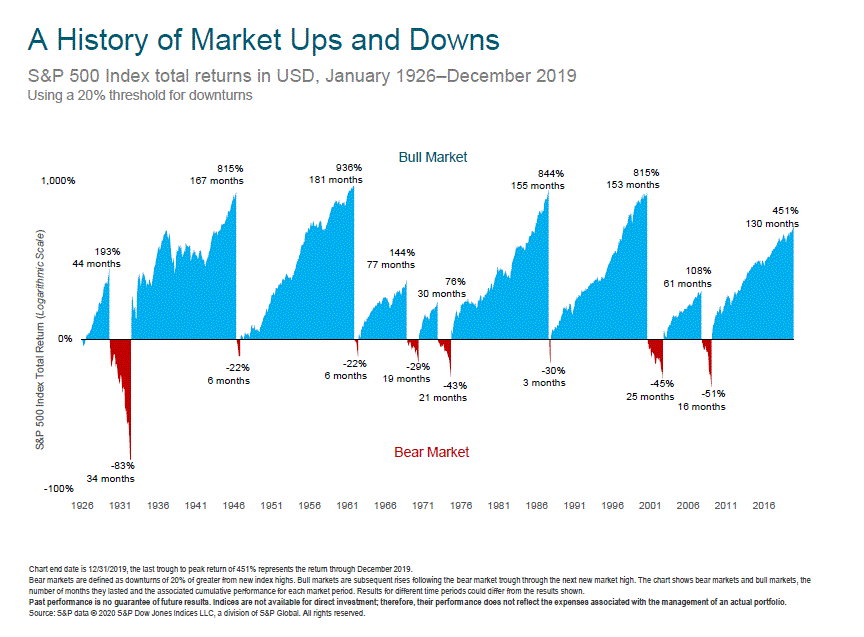Three Questions I’d Ask About Downturns
Stock markets have sold off this year, from what primarily looks like the fear around Russia invading Ukraine. There is also news of higher inflation (after decades of low inflation), as well as interest rates and some other headlines. Recently, the driving force seems to be Russia, however.
So far, what we’re seeing is a very normal type of pullback. As long-term investors, we need to expect downturns from time to time, and this is nothing outside of normal.
However, if this is giving you worry in any way, here are three questions to ask yourself:

Posted by:
Pete Dixon, CFP®
Partner and Advisor
Pandemic Pivots
If the pandemic has proven anything, it’s that life-altering occasions—both those we experience firsthand and those that merely present themselves as possibilities—have the potential to uproot even the firmest of financial plans. Why? Because reminders of what’s most important to us—wake up calls about how we spend our time and, as an extension, our money—can and should trigger reevaluation of our plans for the future.

And although the exact nature of any pandemic-related changes to a financial plan will look different for everyone, a few common themes have surfaced over the last year and a half that are worth discussing with your advisor: > SEE MORE

Posted by:
Waypoint Wealth Management
3 Principles That Round Out Our Strategy
In recent years, U.S. stocks have outperformed international stocks and growth stocks have outperformed value stocks, and this has led many to question the benefits of diversification. We should begin with a look at the appropriate lens through which to view investment strategy performance. Then we will address several issues that work to fog our lens and challenge our ability to stay the course. Taken together, we believe an understanding of these topics fosters the mindset necessary to remain disciplined in the face of adversity.

Posted by:
Waypoint Wealth Management
How Is A Horror Movie Like The Economy And The Markets?
I am not a big fan of scary movies. You know, the ones with the guy in the hockey mask or the girl with the head-spinning thing; that’s just not for me. If I’m honest even just typing those words made me cringe at the memories of seeing those scenes. But there’s an analogy going on between those films and the economy and the stock market. Bear with me, and I’ll explain (hint: it’s not scary).

In those movies, there is a point in which you realize something really, really bad is about to happen. It’s that “oh boy, this is going to be very terrifying” type of moment. Physiologically, some people might experience an increase in heart rate, dryness of mouth, eyes watering or goosebumps. The emotion known as fear is palpable, and we’re anticipating something but we have no idea what to expect.
Some would say (I can’t) that the best horror film keeps this feeling “alive” in you for as long as possible–drawing you in, and keeping you engaged and fearing the absolute worst. Then there is that point that we’re let in. We see the monster, or the face, or the ‘thing’ coming out of the TV and it’s in front of us. It’s at this point that something begins to change. It might be scary, but we know what we’re facing now–it’s in front of us, and there’s almost a sigh of relief as we begin to adapt to a new phase of the film. Some might say “this isn’t really that bad” and the heart rate returns to a more normal pace and the goosebumps subside. Things still need to be dealt with in the movie, but we at least know what we’re dealing with.
How are the economy and the stock market similar to this? > SEE MORE

Posted by:
Pete Dixon, CFP®
Partner and Advisor
A Calm Reflection On The Markets
Many of you may prefer to tune out the financial news, and you may not need much reassurance when we experience bear markets. But the biggest worry that we have is that a client is worried; if that is the case with you please don’t hesitate to call to go over your investment plan.
The most common question we get during times like these is: “your phone must be ringing off the hook.” The truth is, that it is not. That doesn’t mean that we’re less busy in times like these. But we do think the quiet is a testament to not only the planning we’ve done and (hopefully) the perspective we’ve provided you, but also that you’ve placed your trust in us. So thank you for that trust—we don’t take it lightly—and we really mean that we are here for you if you want to call or set up an appointment.
So, another long bull market has come to an end (for now). This happens when a market declines by 20% from its recent high watermark. And, while we tend to focus on the negative aspect (the -20% or more), which we completely understand, we recently came upon the following picture that shows in detail the length and scale of ALL the previous bull markets (and bear markets). What is very evident, is that over time the blue/positive/upturn/bull markets dominate the red/negative/downturn/bear markets.
You can click on the following link to see a larger version of this image: Market Declines and Volatility

This, of course, doesn’t mean that downturns are any less difficult when we’re experiencing them. But sometimes visual evidence can help a long-term investor (like you) remember why we invest in the first place. The positive growth outlasts the negative (every time so far) and the net outcome is expected growth. We don’t know when the next upturn will begin. But staying invested means that we’ll be there when it does.
Past performance is no guarantee of future results. Indices are not available for direct investment; therefore, their performance does not reflect the expenses associated with the management of an actual portfolio.

Posted by:










